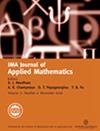具有四次边际稳定曲线的广义Swift–Hohenberg方程的局部化模式
IF 1.4
4区 数学
Q2 MATHEMATICS, APPLIED
引用次数: 3
摘要
在一些图案形成系统中,对于一些参数值,图案以两个波长形成,而对于其他参数值,只有一个波长。它们之间的过渡可以通过一个余维三点来组织,在该点处,边际稳定性曲线具有四次极小值。我们基于Swift–Hohenberg方程开发了一个模型方程来探索这种情况;该模型包括一个波长的图案的蛇形分支,这些分支定位在另一波长的图案背景中。在小振幅极限下,该模型的振幅方程是具有四阶空间导数的广义Ginzburg–Landau方程,可以采用具有实系数的复Swift–Hohenberg方程的形式。该振幅方程中的局部化解有助于解释模型中的局部化模式。这项工作扩展了最近研究模式形成系统中的蛇形行为的努力,其中在相同的参数值下存在两个不同的稳定非平凡模式。本文章由计算机程序翻译,如有差异,请以英文原文为准。
Localized patterns in a generalized Swift–Hohenberg equation with a quartic marginal stability curve
In some pattern-forming systems, for some parameter values, patterns form with two wavelengths, while for other parameter values, there is only one wavelength. The transition between these can be organized by a codimension-three point at which the marginal stability curve has a quartic minimum. We develop a model equation to explore this situation, based on the Swift–Hohenberg equation; the model contains, amongst other things, snaking branches of patterns of one wavelength localized in a background of patterns of another wavelength. In the small-amplitude limit, the amplitude equation for the model is a generalized Ginzburg–Landau equation with fourth-order spatial derivatives, which can take the form of a complex Swift–Hohenberg equation with real coefficients. Localized solutions in this amplitude equation help interpret the localized patterns in the model. This work extends recent efforts to investigate snaking behaviour in pattern-forming systems where two different stable non-trivial patterns exist at the same parameter values.
求助全文
通过发布文献求助,成功后即可免费获取论文全文。
去求助
来源期刊
CiteScore
2.30
自引率
8.30%
发文量
32
审稿时长
24 months
期刊介绍:
The IMA Journal of Applied Mathematics is a direct successor of the Journal of the Institute of Mathematics and its Applications which was started in 1965. It is an interdisciplinary journal that publishes research on mathematics arising in the physical sciences and engineering as well as suitable articles in the life sciences, social sciences, and finance. Submissions should address interesting and challenging mathematical problems arising in applications. A good balance between the development of the application(s) and the analysis is expected. Papers that either use established methods to address solved problems or that present analysis in the absence of applications will not be considered.
The journal welcomes submissions in many research areas. Examples are: continuum mechanics materials science and elasticity, including boundary layer theory, combustion, complex flows and soft matter, electrohydrodynamics and magnetohydrodynamics, geophysical flows, granular flows, interfacial and free surface flows, vortex dynamics; elasticity theory; linear and nonlinear wave propagation, nonlinear optics and photonics; inverse problems; applied dynamical systems and nonlinear systems; mathematical physics; stochastic differential equations and stochastic dynamics; network science; industrial applications.

 求助内容:
求助内容: 应助结果提醒方式:
应助结果提醒方式:


